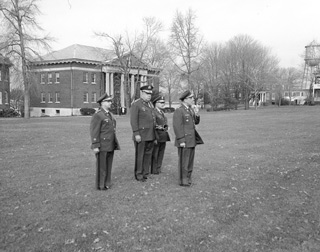| World Events |
|
Former residents often describe the small-town atmosphere and comparative isolation of Fort Slocum in peacetime. Its role as an installation of the U.S. military, however, demanded that the post respond promptly and wholeheartedly when the Army was called to action. War and imminent threat of war dissolved the post’s seeming isolation. Its personnel went off to battle, and sometimes later news of them was sad and grim.
Fort Slocum’s mission began during the Civil War. The post provided recruits by the thousands to western forts during the late Indian Wars of the 1880s and assembled troops during the Spanish-American War. In the 20th century Fort Slocum shipped tens of thousands of soldiers to Europe during the First and Second World Wars. Between the wars the post sent troops overseas to U.S. territories and possessions, such as the Phillippines, Hawaii, the Canal Zone, and Puerto Rico. Transferred to the Air Force after the Second World War, the post was briefly deactivated at the end of the 1940s, then reopened with the Korean War. The post closed for good in the mid-1960s at the time when America’s involvement in Vietnam was deepening in the mid-1960s.
Events at home and abroad touched those at Fort Slocum, and for many, the episodes were closely associated in memory with their years at the post. One former resident claimed to recall the passage of the zeppelin Hindenburg in 1937 shortly before it exploded in Lakehurst, New Jersey. Others remembered the activity and opportunities of the Second World War or the crises of the early 1960s.
Historians sometimes call the Second World War America’s “good war” for its comparative moral clarity and broad popular support. Most of the fighting was far from American shores, but stateside the war seemed ever-present and involved nearly everyone. After the relative quiet of the 1920s and 1930s, Fort Slocum became a busy place starting in 1940 as a training center and staging area. Memories of the Second World War remain vivid for those who then lived or served at Fort Slocum.
The Cold War soon followed the Second World War, and Fort Slocum served its last missions for the U.S. Army during this period. In the Cold War, America and the Soviet Union competed for dominance around the globe. This competition had many facets—military, economic, and ideological. Shaping the entire confrontation was the threat of nuclear war, which could bring destruction to the world on a horrific scale.
Before it closed in the midst of the Cold War, Fort Slocum participated primarily in the ideological aspects of the confrontation. It trained specialists who provided information from the Army’s point of view both to soldiers and to the general public. It also trained the chaplains who provided American ground forces with spiritual guidance and sustenance. While the vast majority of students in these training schools were Americans, occasional members of allied foreign armed forces would attend as well. |




 World Events
World Events